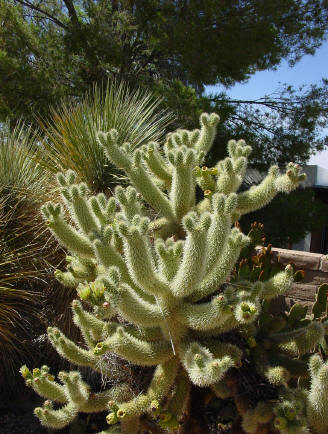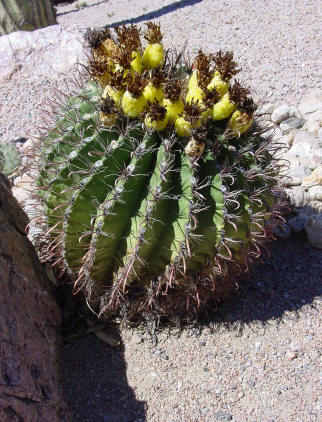Shirley Lindsey
Adams County Master Gardener
 Some people head south as soon as it gets below freezing and stay all winter. Others like to warm up for a few weeks and then come back to their home area. If you are looking for sunshine, there is no better place than the Southwest. Even
better, if you go in April, you will find the desert in full bloom. Many of us who especially enjoy our green summers find the Southwest to be dull and drab most of the year. But if you go in the spring, you will be fascinated by all the various cactus blooms and other desert plants that are having their show at that time.
Some people head south as soon as it gets below freezing and stay all winter. Others like to warm up for a few weeks and then come back to their home area. If you are looking for sunshine, there is no better place than the Southwest. Even
better, if you go in April, you will find the desert in full bloom. Many of us who especially enjoy our green summers find the Southwest to be dull and drab most of the year. But if you go in the spring, you will be fascinated by all the various cactus blooms and other desert plants that are having their show at that time.
A visit to the Arizona-Sonora Desert Museum was the highlight of our trip. Many of the native trees, grasses, shrubs and flowers are displayed. What a unique and wonderful environment. We saw many animals native to the desert climate, and the adaptation of plants to their climate is truly amazing!
As a visitor to the Tucson area, I found the palo verde tree to be fascinating. This tree, at least in April when I saw it, was leafless. However, the whole tree -- limbs, bark, trunk and all -- was a bright lime green. Depending on the amount of moisture or lack of it, the tree does not leaf out.
But the bark itself takes in the necessary nutrients to keep it alive. When it does leaf out, this tree has very tiny compound leaves and yellow blossoms. The mesquite tree was also a very interesting specimen with long droopy blossoms and dainty compound leaves.
 If you want some of the uniqueness of the desert Southwest, there are many things we can grow right here in south central Pennsylvania. Some of these plants are good
choices, especially when one considers the water shortages we have had during recent growing seasons. One of the common plants we see is yucca. There are numerous varieties of this species. They have stiff sharp leaves-don't plant them near walks or doorways. They are not called 'Spanish dagger' for nothing. While they are
not particular about soil, most varieties should be planted in full sun and wet areas should be avoided. Most of us are familiar with the prickly pear cactus. This plant, as well as the cholla, is of the genus Opuntia. They vary in size from less than one foot tall to 6 or 7 feet. The blossoms may be red, yellow or purple.
We saw some with yellow blossoms and lavender purple pads. The prickly pear fruits, along with the pads and leaves, are often eaten. They are rich in soluble fibers and are thought to help diabetics keep blood sugar under control.
If you want some of the uniqueness of the desert Southwest, there are many things we can grow right here in south central Pennsylvania. Some of these plants are good
choices, especially when one considers the water shortages we have had during recent growing seasons. One of the common plants we see is yucca. There are numerous varieties of this species. They have stiff sharp leaves-don't plant them near walks or doorways. They are not called 'Spanish dagger' for nothing. While they are
not particular about soil, most varieties should be planted in full sun and wet areas should be avoided. Most of us are familiar with the prickly pear cactus. This plant, as well as the cholla, is of the genus Opuntia. They vary in size from less than one foot tall to 6 or 7 feet. The blossoms may be red, yellow or purple.
We saw some with yellow blossoms and lavender purple pads. The prickly pear fruits, along with the pads and leaves, are often eaten. They are rich in soluble fibers and are thought to help diabetics keep blood sugar under control.
The cholla was one of my favorite cacti. There are 28 varieties of cholla (pronounced choya) and the blossoms were magnificent. They grow from below sea level to 4,000 feet elevation. While the 'teddy bear' cholla looks like you could pick it up and cuddle it, that is not recommended. A good rule of
thumb is to keep a respectful distance from any cactus. The spines are meant to sink in and not come out without pain.
 The barrel cactus, genus Ferocactus, is easily recognized by its barrel shape. The blossoms grow in a crown shape at the top. The flowers are usually yellow-green or red. These
plants are found throughout the desert southwest. The flowers have been eaten cooked like cabbage, or older flowers boiled to make a drink. Also the pulp of this plant has been scooped out for use as food. This can also be used as a source of emergency fluid in the desert, although it might be difficult to get to the
inside without the proper tools. One cactus grower uses a long pair of tongs to work with her plants. The barrel cactus has also been used by natives of the area as a container.
The barrel cactus, genus Ferocactus, is easily recognized by its barrel shape. The blossoms grow in a crown shape at the top. The flowers are usually yellow-green or red. These
plants are found throughout the desert southwest. The flowers have been eaten cooked like cabbage, or older flowers boiled to make a drink. Also the pulp of this plant has been scooped out for use as food. This can also be used as a source of emergency fluid in the desert, although it might be difficult to get to the
inside without the proper tools. One cactus grower uses a long pair of tongs to work with her plants. The barrel cactus has also been used by natives of the area as a container.
A desert trip would not be complete without mention of the magnificent saguaro. These awesome plants stand guard in the desert with arms raised. They grow slowly but may reach heights of 50 feet and live up to 200 years. The Carnegiea gigantea blossom is the state flower of Arizona. Creamy white 3-
inch flowers open at night and close by mid-day. These plants are pollinated by birds, bats, and insects. The Gila woodpeckers peck out a hole, which then seals and gives them a spot to make their nests. The buds appear in mid-April and flowers in May.
Read other articles on plants and gardens
Read other articles by Shirley Lindsey